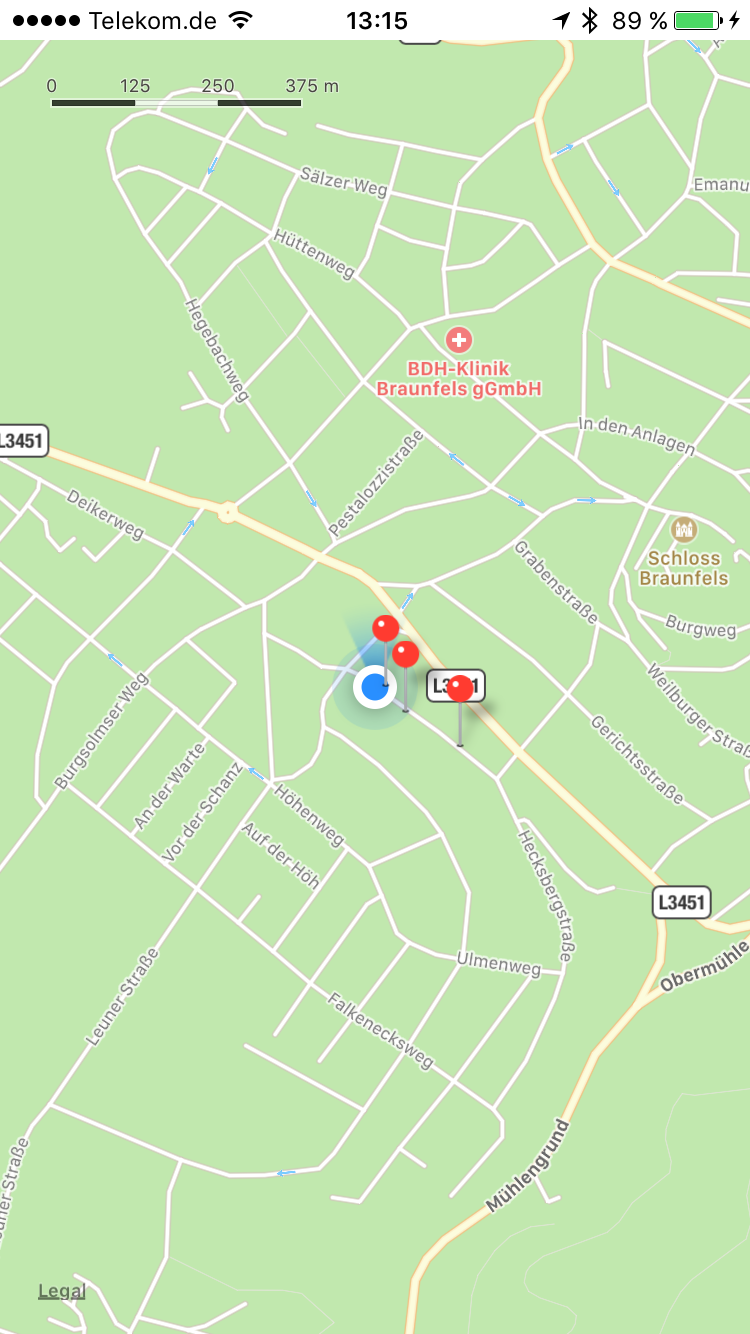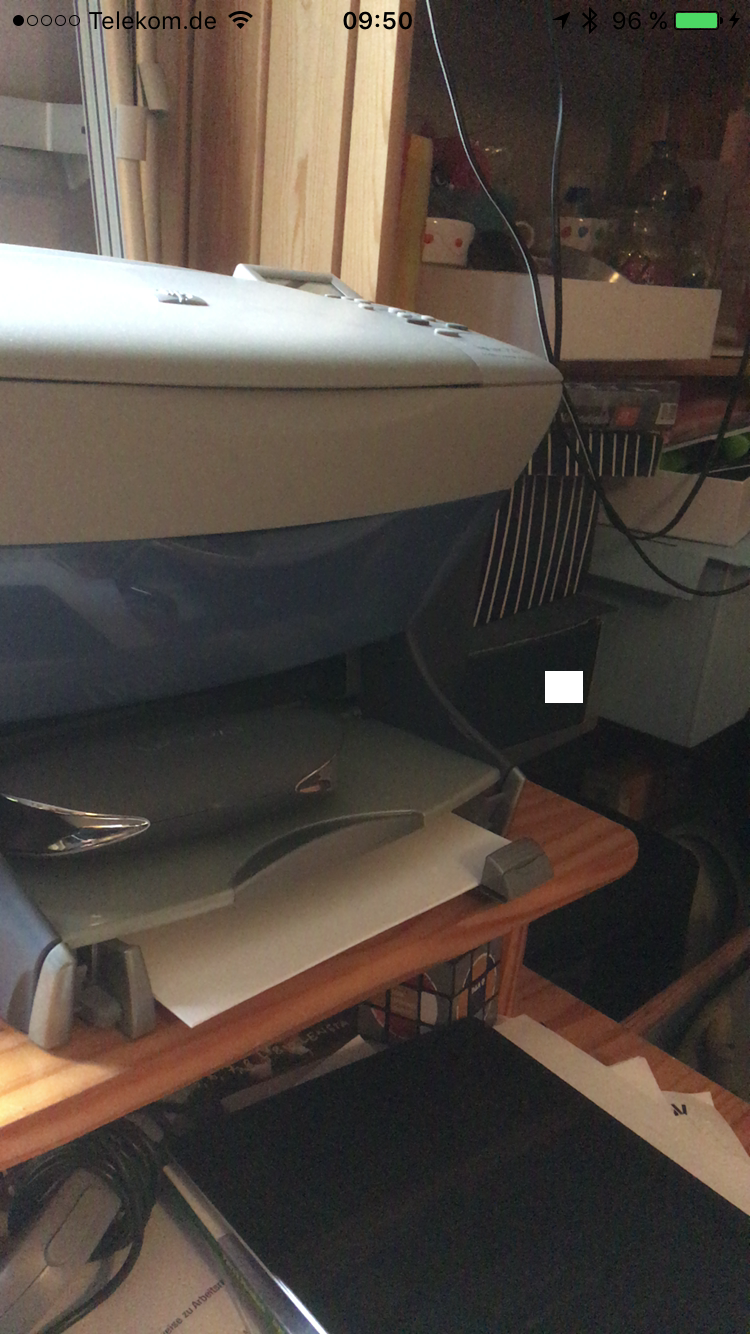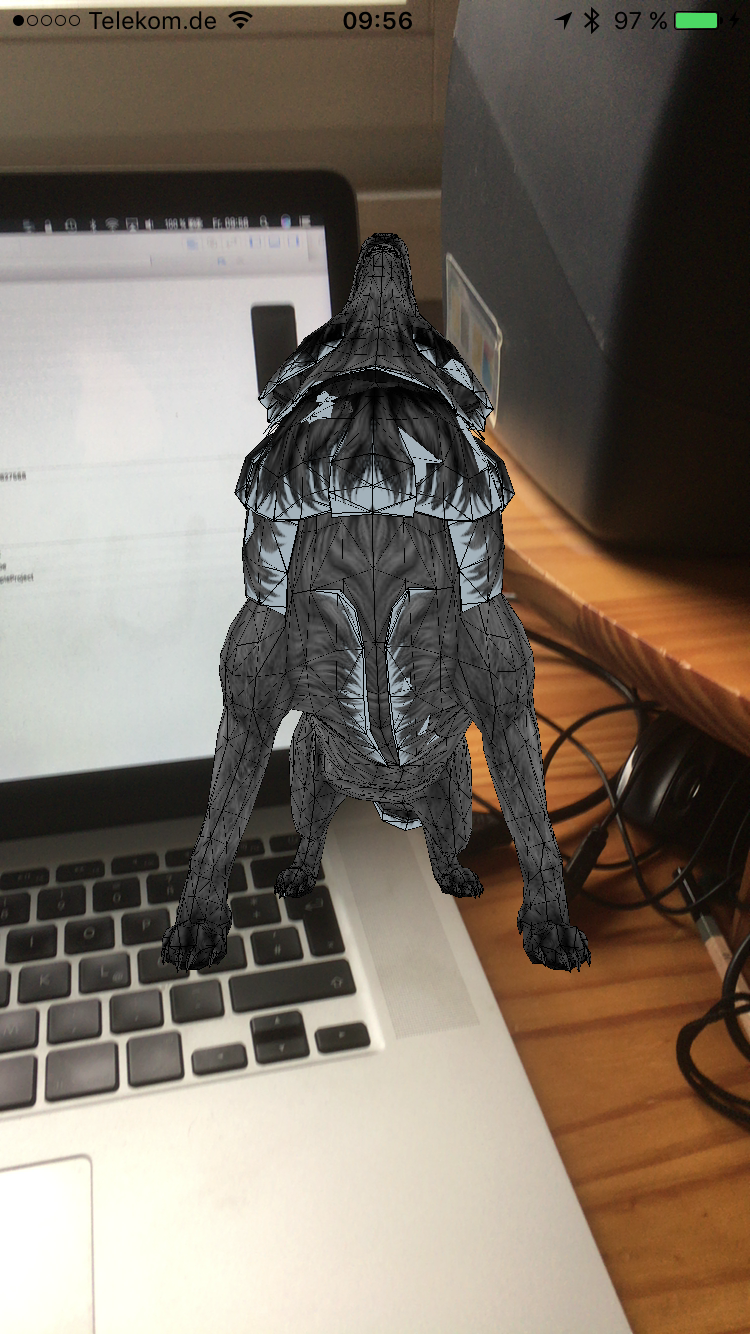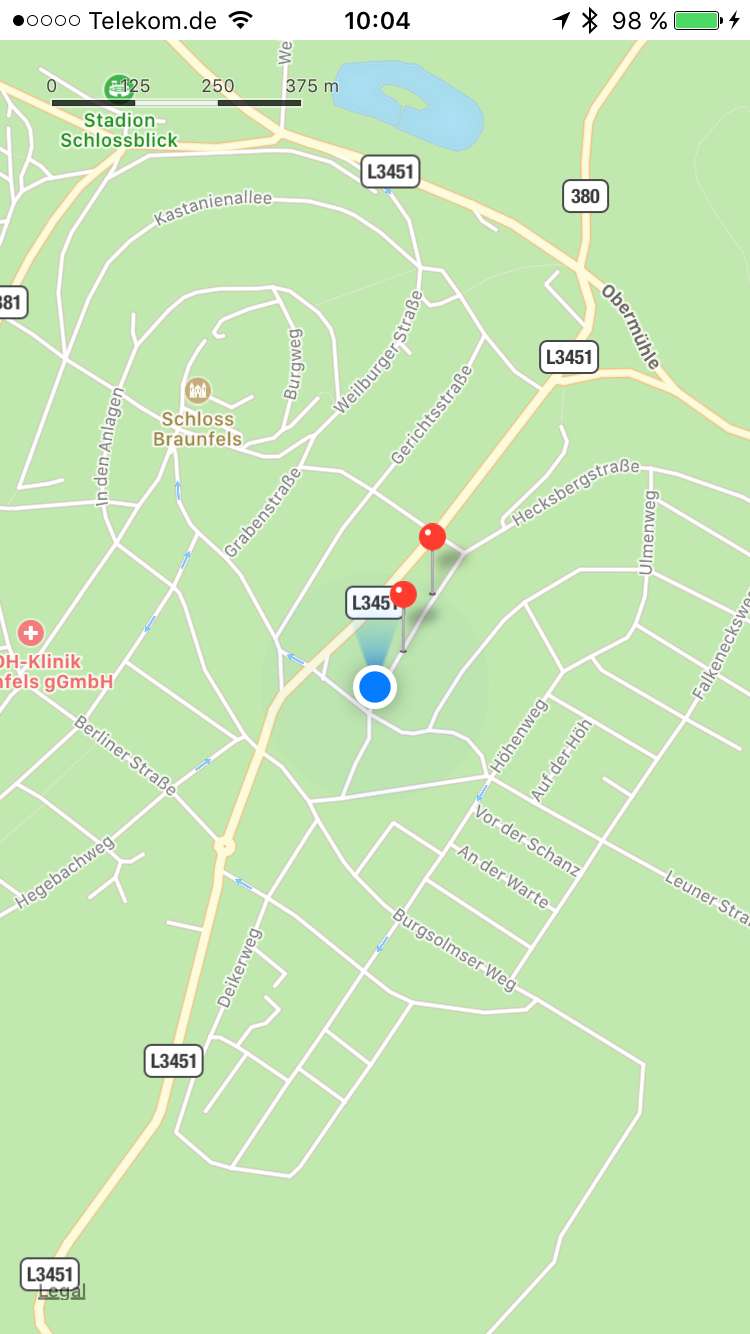原文:How To Make An App Like Pokemon Go
作者:Jean-Pierre Distler
译者:kmyhy
如今最流行的一个手机游戏就是精灵宝可梦。它使用增强现实技术将游戏带入到“真实世界”,让玩家做一些对健康有益的事情。
在本教程中,我们将编写自己的增强现实精灵捕获游戏。这个游戏会显示一张包含有你的位置和敌人的位置的地图,用一个 3D SceneKit 视图呈现后置摄像头中拍摄的图像和敌人的 3D 模型。
如果你第一次接触增强现实,你可以先看一下我们的基于地理位置的 RA 教程。对于要介绍如何编写精灵宝可梦 app 的本教程来说,它不是必须的,但它里面包含了大量本教程未涉及的关于数学和 RA 的有用知识。
本教程的开始项目在此处下载。项目包含了两个 view controller 和一个 art.scnassets 文件夹,这个文件夹中包括了必须的 3D 模型和贴图。
ViewController.swift 是一个 UIViewController 子类,用于显示 app 的 AR 内容。MapViewController 用于显示一张地图,地图上会包含你的当前位置以及附近敌人的位置。一些基本的东西,比如约束和出口,都是已经建好的了,你只需要关注本教程的核心内容,即怎样让 app 长得像精灵宝可梦。
在你能够和敌人战斗之前,需要知道敌人在哪。新建一个 Swift 文件,叫做 ARItem.swift。
在文件的 ARItem.swift 的 import Foundation 一行后添加:
import CoreLocationstruct ARItem { let itemDescription: String let location: CLLocation}ARItem 有一个描述字段和一个坐标。这样我们就能够知道是什么样的敌人,以及它在哪里。
打开 MapViewController.swift 添加一个 impor CoreLocation 语句以及一个属性:
var targets = [ARItem]()添加如下方法:
func setupLocations() { let firstTarget = ARItem(itemDescription: "wolf", location: CLLocation(latitude: 0, longitude: 0)) targets.append(firstTarget) let secondTarget = ARItem(itemDescription: "wolf", location: CLLocation(latitude: 0, longitude: 0)) targets.append(secondTarget) let thirdTarget = ARItem(itemDescription: "dragon", location: CLLocation(latitude: 0, longitude: 0)) targets.append(thirdTarget) }我们通过硬编码的方式创建了 3 个敌人。我们会将坐标(0,0) 替换成靠近你物理坐标附近的坐标。
有许多查找坐标的方法。比如,可以在你当前位置附近创建一些随机的坐标,使用我们在上一篇教程的 PlacesLoader 或者 Xcode 模拟当前位置。当然,我们不想让随机坐标出现在你邻居的卧室里。那就尴尬了。
简单点的方法,就是使用 Google 地图。打开 https://www.google.com/maps/ 查找你当前的位置。当你点击地图,会显示一个大头钉,底部弹出一个气泡。
在气泡中会显示你的经纬度。我建议你从你的位置或你所在的街道附近创建出一些硬编码的位置,这样你就没有必要去敲邻居家门,告诉他你需要去他的卧室抓一条龙。
选择 3 个位置,将上面代码中的 0 替换成你选择的坐标。

我们已经设定了敌人的坐标,应该在地图上将它们显示出来。新增一个 Swift 文件,取名为 MapAnnotation.swift。在这个文件中编写如下代码:
import MapKitclass MapAnnotation: NSObject, MKAnnotation { //1 let coordinate: CLLocationCoordinate2D let title: String? //2 let item: ARItem //3 init(location: CLLocationCoordinate2D, item: ARItem) { self.coordinate = location self.item = item self.title = item.itemDescription super.init() }}我们创建了一个 MapAnnotation 类并实现了 MKAnnotation 协议。
回到 MapViewController.swift 在 setupLocations() 方法最后一句添加:
for item in targets { let annotation = MapAnnotation(location: item.location.coordinate, item: item) self.mapView.addAnnotation(annotation) }循环遍历 targets 数组,每个 target 都会添加一个大头钉到地图上。
在 viewDidLoad() 方法最后调用 setupLocations():
override func viewDidLoad() { super.viewDidLoad() mapView.userTrackingMode = MKUserTrackingMode.followWithHeading setupLocations()}在定位之前,我们必须获得权限。
在 MapViewController 中添加一个新属性:
let locationManager = CLLocationManager()在 viewDidLoad() 最后一句,添加请求权限的代码:
if CLLocationManager.authorizationStatus() == .notDetermined { locationManager.requestWhenInUseAuthorization()}注意:如果不进行权限请求,map view 无法加载用户位置。而且不会提示任何错误信息。每当你调用位置服务时,你都无法获得位置信息,要排除错误请首先从这个地方开始。
运行 app,等一会地图将缩放到你的当前位置并显示出一些红色的大头钉,它们表示了敌人的位置。

我们有一个看起来不错的 app,但我们还需要添加一些 AR 元素。在下一节,我们将添加一个摄像窗口并添加一个简单的方块来代表敌人。
首先我们需要跟踪用户位置。在 MapViewController 声明属性:
var userLocation: CLLocation?然后添加一个扩展:
extension MapViewController: MKMapViewDelegate { func mapView(_ mapView: MKMapView, didUpdate userLocation: MKUserLocation) { self.userLocation = userLocation.location }}每次设备的位置发生改变,这个方法会被调用。这个方法中,我们简单地保存了用户位置,以便在另一个方法中使用。
在扩展中添加委托方法:
func mapView(_ mapView: MKMapView, didSelect view: MKAnnotationView) { //1 let coordinate = view.annotation!.coordinate //2 if let userCoordinate = userLocation { //3 if userCoordinate.distance(from: CLLocation(latitude: coordinate.latitude, longitude: coordinate.longitude)) < 50 { //4 let storyboard = UIStoryboard(name: "Main", bundle: nil) if let viewController = storyboard.instantiateViewController(withIdentifier: "ARViewController") as? ViewController { // more code later //5 if let mapAnnotation = view.annotation as? MapAnnotation { //6 self.present(viewController, animated: true, completion: nil) } } } }}当用户点击到一个距离你不超过 50 米的敌人时,显示一个摄像画面:
运行 app,点击你位置附近的任意大头钉,会显示一个空白的 view controller:

打开 ViewController.swift,在 import SceneKit 后面添加 import AVFoundation:
import UIKitimport SceneKitimport AVFoundationclass ViewController: UIViewController {...添加两个属性用于保存一个 AVCaptureSession 对象和一个 AVCaptureVideoPreviewLayer 对象:
var cameraSession: AVCaptureSession?var cameraLayer: AVCaptureVideoPreviewLayer?我们会用 capture session 来访问视频输入(比如镜头)和输出(比如取景框)。
添加一个方法:
func createCaptureSession() -> (session: AVCaptureSession?, error: NSError?) { //1 var error: NSError? var captureSession: AVCaptureSession? //2 let backVideoDevice = AVCaptureDevice.defaultDevice(withDeviceType: .builtInWideAngleCamera, mediaType: AVMediaTypeVideo, position: .back) //3 if backVideoDevice != nil { var videoInput: AVCaptureDeviceInput! do { videoInput = try AVCaptureDeviceInput(device: backVideoDevice) } catch let error1 as NSError { error = error1 videoInput = nil } //4 if error == nil { captureSession = AVCaptureSession() //5 if captureSession!.canAddInput(videoInput) { captureSession!.addInput(videoInput) } else { error = NSError(domain: "", code: 0, userInfo: ["description": "Error adding video input."]) } } else { error = NSError(domain: "", code: 1, userInfo: ["description": "Error creating capture device input."]) } } else { error = NSError(domain: "", code: 2, userInfo: ["description": "Back video device not found."]) } //6 return (session: captureSession, error: error)}这个方法负责这些事情:
现在我们已经从摄像头拿到输入了,就可以把它添加到视图中:
func loadCamera() { //1 let captureSessionResult = createCaptureSession() //2 guard captureSessionResult.error == nil, let session = captureSessionResult.session else { print("Error creating capture session.") return } //3 self.cameraSession = session //4 if let cameraLayer = AVCaptureVideoPreviewLayer(session: self.cameraSession) { cameraLayer.videoGravity = AVLayerVideoGravityResizeAspectFill cameraLayer.frame = self.view.bounds //5 self.view.layer.insertSublayer(cameraLayer, at: 0) self.cameraLayer = cameraLayer }}代码解释如下:
然后,在 viewDidLoad() 加入:
loadCamera() self.cameraSession?.startRunning()这里只做了两件事情:首先调用前面编写的方法,然后打开镜头取景框。这个取景框立马会显示到预览图层上。
运行 app,点击你身边的任何一个位置,你会看到一个全新的镜头预览界面:

干得不错,但这还不算真正的 RA。在这一节,我们将添加一个简单的方块来表示敌人,并根据用户的位置和朝向来移动它。
这个游戏会有两种敌人:狼和龙。
因此,我们需要知道敌人的种类以及应该在哪里显示它们。
在 ViewController 中添加如下属性(用于保存敌人的信息):
var target: ARItem!打开 MapViewController.swift, 找到 mapView(_:, didSelect:) 将最后一个 if 语句修改为:
if let mapAnnotation = view.annotation as? MapAnnotation { //1 viewController.target = mapAnnotation.item self.present(viewController, animated: true, completion: nil)}在显示 viewController 之前,将一个 ARItem(它是被点击的大头钉的 item 属性)赋给它。这样,viewController 就能够知道当前敌人的种类。
现在 ViewController 已经获得了 target 的信息了。
打开 ARItem.swift 导入 SceneKit。
import Foundationimport SceneKitstruct ARItem {...}添加一个属性,用于保存一个 SCNNode 对象:
var itemNode: SCNNode?确保这个属性声明在 ARItem 结构的其它属性之后,因为在隐式的初始化方法将使用相同的顺序来定义参数。
Xcode 会提示 MapViewController.swift 中有一个错误。要解决这个错误,请打开这个文件,找到 setupLocations() 方法。
我们需要修改在编辑器左边标有一个红点的代码。
![]()
对于这些代码,我们都需要将缺少的 itemNode 参数用 nil 来补上。
例如,这一行:
let firstTarget = ARItem(itemDescription: "wolf", location: CLLocation(latitude: 50.5184, longitude: 8.3902))应当改为:
let firstTarget = ARItem(itemDescription: "wolf", location: CLLocation(latitude: 50.5184, longitude: 8.3902), itemNode: nil)我们知道了敌人的种类,以及它们的位置,但我们还需要知道设备当前朝向。
打开 ViewController.swift ,导入 CoreLocation:
import UIKitimport SceneKitimport AVFoundationimport CoreLocation然后,增加属性声明:
//1var locationManager = CLLocationManager()var heading: Double = 0var userLocation = CLLocation()//2let scene = SCNScene()let cameraNode = SCNNode()let targetNode = SCNNode(geometry: SCNBox(width: 1, height: 1, length: 1, chamferRadius: 0))代码解释如下:
在 viewDidLoad() 最后一句添加:
//1self.locationManager.delegate = self//2self.locationManager.startUpdatingHeading()//3sceneView.scene = scene cameraNode.camera = SCNCamera()cameraNode.position = SCNVector3(x: 0, y: 0, z: 10)scene.rootNode.addChildNode(cameraNode)代码解释如下:
添加一个扩展,实现 CLLocationManagerDelegate 协议:
extension ViewController: CLLocationManagerDelegate { func locationManager(_ manager: CLLocationManager, didUpdateHeading newHeading: CLHeading) { //1 self.heading = fmod(newHeading.trueHeading, 360.0) repositionTarget() }}当收到新的方向通知,CLLocationManager 会调用这个委托方法。fmod 对 double 进行取模运算,确保方向的取值位于 0-359 之间。
在 ViewController.swift 中添加一个 repostionTarget()方法,注意是放在类实现而不是 CLLocationManagerDelegate 扩展中:
func repositionTarget() { //1 let heading = getHeadingForDirectionFromCoordinate(from: userLocation, to: target.location) //2 let delta = heading - self.heading if delta < -15.0 { leftIndicator.isHidden = false rightIndicator.isHidden = true } else if delta > 15 { leftIndicator.isHidden = true rightIndicator.isHidden = false } else { leftIndicator.isHidden = true rightIndicator.isHidden = true } //3 let distance = userLocation.distance(from: target.location) //4 if let node = target.itemNode { //5 if node.parent == nil { node.position = SCNVector3(x: Float(delta), y: 0, z: Float(-distance)) scene.rootNode.addChildNode(node) } else { //6 node.removeAllActions() node.runAction(SCNAction.move(to: SCNVector3(x: Float(delta), y: 0, z: Float(-distance)), duration: 0.2)) } }}代码解释如下:
如果你懂 SceneKit 或者 SpriteKit,则最后一句代码你懂的。否则,这里会进行更详细的介绍。
SCNAction.move(to:, duration:) 方法创建一个 action,将节点以指定时间移动到指定的位置。runAction(_:) 也是 SCNNode 方法,用于执行一个 action。我们还可以创建 action 组/序列。要了解更多内容,请阅读我们的这本书3D Apple Games by Tutorials。
继续实现前面未实现的方法。在 ViewController.swift 中添加这几个方法:
func radiansToDegrees(_ radians: Double) -> Double { return (radians) * (180.0 / M_PI)}func degreesToRadians(_ degrees: Double) -> Double { return (degrees) * (M_PI / 180.0)}func getHeadingForDirectionFromCoordinate(from: CLLocation, to: CLLocation) -> Double { //1 let fLat = degreesToRadians(from.coordinate.latitude) let fLng = degreesToRadians(from.coordinate.longitude) let tLat = degreesToRadians(to.coordinate.latitude) let tLng = degreesToRadians(to.coordinate.longitude) //2 let degree = radiansToDegrees(atan2(sin(tLng-fLng)*cos(tLat), cos(fLat)*sin(tLat)-sin(fLat)*cos(tLat)*cos(tLng-fLng))) //3 if degree >= 0 { return degree } else { return degree + 360 }}radiansToDegrees(_:) 和 degreesToRadians(_:) 方法用于将弧度和角度互转。
getHeadingForDirectionFromCoordinate(from:to:) 方法代码解释如下:
还需要几个步骤才能运行你的 app。
首先,必须将用户的坐标传递给 viewController。打开 MapViewController.swift 找到 mapView(_:, didSelect:) 的最后一个 if 语句,在显示 view controller 之前加上这句:
viewController.userLocation = mapView.userLocation.location!然后在 ViewController.swift 中添加这个方法:
func setupTarget() { targetNode.name = "enemy" self.target.itemNode = targetNode }这个方法为 targetNode 设置一个名字,然后将它赋给 target。
现在可以在 viewDidLoad() 方法最后来调用这个方法了。在添加完摄像头之后添加:
scene.rootNode.addChildNode(cameraNode)setupTarget()运行 app,可以看到方块在移动:

在开发 app 初期用方块或者圆球是一种简单的处理方法,因为这样省去了大量 3D 建模的时间——但 3D 模型看起来毕竟要漂亮得多。在这一节,我们将继续美化我们的 app ,为敌人加入 3D 模型,以及赋予玩家扔出火球的能力。
打开 art.scnassets 文件夹,里面有两个 .dae 文件。它们包含了敌人的模型:狼和龙。
接下来修改 ViewController.swift 中的 setupTarget() 方法,在其中加载这些 3D 模型并赋给目标的 itemNode 属性。
将 setupTarget() 方法修改为:
func setupTarget() { //1 let scene = SCNScene(named: "art.scnassets/\(target.itemDescription).dae") //2 let enemy = scene?.rootNode.childNode(withName: target.itemDescription, recursively: true) //3 if target.itemDescription == "dragon" { enemy?.position = SCNVector3(x: 0, y: -15, z: 0) } else { enemy?.position = SCNVector3(x: 0, y: 0, z: 0) } //4 let node = SCNNode() node.addChildNode(enemy!) node.name = "enemy" self.target.itemNode = node}代码解释如下:
运行 app,你会看到一只立体的狼,这可比一个便宜的方块要吓人多了!
事实上,这只狼足以让你吓得远远抛开了,但作为勇敢主角的你,逃跑从来不是你的选择!接下来你应该加上几个火球,这样你就能在成为狼的点心之前战胜它了。
抛出火球的最好时机是用户的触摸结束事件,因此在 ViewController.swift 中实现这个方法:
override func touchesEnded(_ touches: Set<UITouch>, with event: UIEvent?) { //1 let touch = touches.first! let location = touch.location(in: sceneView) //2 let hitResult = sceneView.hitTest(location, options: nil) //3 let fireBall = SCNParticleSystem(named: "Fireball.scnp", inDirectory: nil) //4 let emitterNode = SCNNode() emitterNode.position = SCNVector3(x: 0, y: -5, z: 10) emitterNode.addParticleSystem(fireBall!) scene.rootNode.addChildNode(emitterNode) //5 if hitResult.first != nil { //6 target.itemNode?.runAction(SCNAction.sequence([SCNAction.wait(duration: 0.5), SCNAction.removeFromParentNode(), SCNAction.hide()])) let moveAction = SCNAction.move(to: target.itemNode!.position, duration: 0.5) emitterNode.runAction(moveAction) } else { //7 emitterNode.runAction(SCNAction.move(to: SCNVector3(x: 0, y: 0, z: -30), duration: 0.5)) }}代码解释如下:
运行 app,让恶饿狼在火焰中焚烧吧!

要完成 app,我们还需要将敌人从列表中删除,关闭 AR 视图并回到地图,以便找到下一个敌人。
移除敌人应当在 MapViewController 中进行,因为敌人列表就在那里。我们可以说明只有一个方法的委托协议,当目标被击中后调用这个方法。
在 ViewController.swift 的类声明之前,添加如下协议:
protocol ARControllerDelegate { func viewController(controller: ViewController, tappedTarget: ARItem)}同时为 ViewController 声明一个属性:
var delegate: ARControllerDelegate?委托方法会告诉委托对象说明时候发生了碰撞事件,然后委托对象就可以进行下一步的处理。
在 ViewController.swift 中找到 touchesEnded(_:with:) 方法,将if 语句中的代码块修改为:
if hitResult.first != nil { target.itemNode?.runAction(SCNAction.sequence([SCNAction.wait(duration: 0.5), SCNAction.removeFromParentNode(), SCNAction.hide()])) //1 let sequence = SCNAction.sequence( [SCNAction.move(to: target.itemNode!.position, duration: 0.5), //2 SCNAction.wait(duration: 3.5), //3 SCNAction.run({_ in self.delegate?.viewController(controller: self, tappedTarget: self.target) })]) emitterNode.runAction(sequence)} else { ...}解释如下:
打开 MapViewController.swift 声明一个属性,用于保存 选中的大头钉:
var selectedAnnotation: MKAnnotation?这个属性用于待会将它从地图上移出。修改它的 viewController 的初始化和条件绑定(if let)部分的代码:
if let viewController = storyboard.instantiateViewController(withIdentifier: "ARViewController") as? ViewController { //1 viewController.delegate = self if let mapAnnotation = view.annotation as? MapAnnotation { viewController.target = mapAnnotation.item viewController.userLocation = mapView.userLocation.location! //2 selectedAnnotation = view.annotation self.present(viewController, animated: true, completion: nil) }}非常简单:
在 MKMapViewDelegate 扩展下面添加:
extension MapViewController: ARControllerDelegate { func viewController(controller: ViewController, tappedTarget: ARItem) { //1 self.dismiss(animated: true, completion: nil) //2 let index = self.targets.index(where: {$0.itemDescription == tappedTarget.itemDescription}) self.targets.remove(at: index!) if selectedAnnotation != nil { //3 mapView.removeAnnotation(selectedAnnotation!) } }}代码解释如下:
运行 app,你将看到最终效果:

最终完成的项目在这里下载。
如果你想尽可能地学习如何编写这个 app,请参考下列教程:
希望你喜欢本教程。如果有任何问题和建议,请在下面留言。
$(function () {
$(‘pre.prettyprint code‘).each(function () {
var lines = $(this).text().split(‘\n‘).length;
var $numbering = $(‘